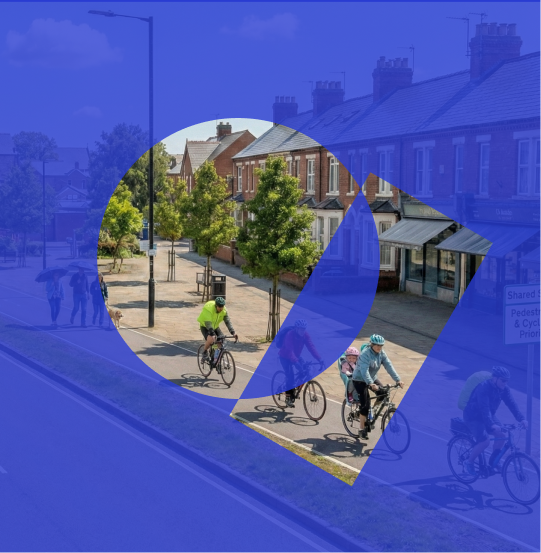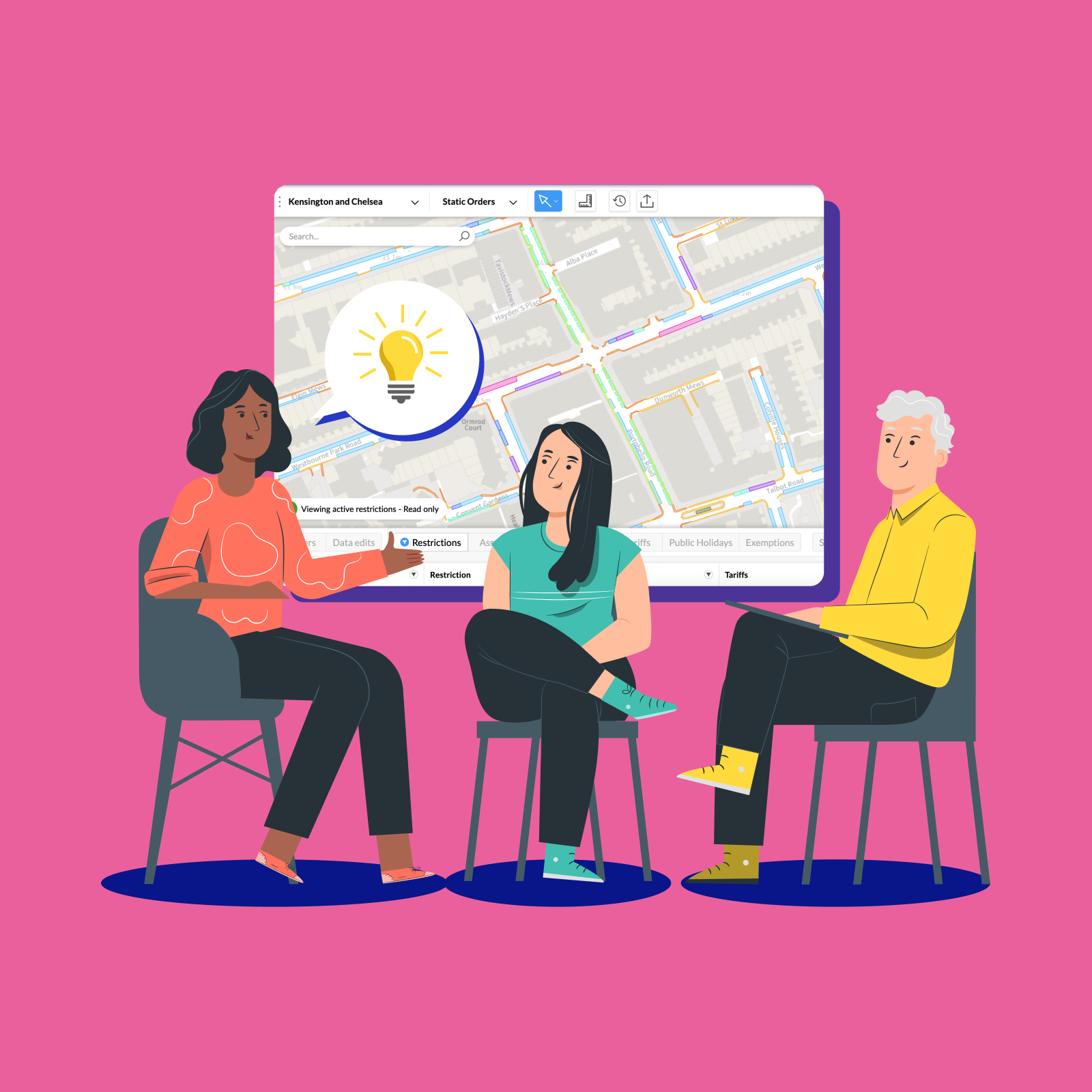Know your D-TROs from your NPPs with the AppyWay glossary
A
Active Travel
A form of transportation that involves physical activity, such as walking or cycling, instead of using motorised vehicles. This promotes health, reduces traffic congestion, and lowers emissions.
API
An API, or Application Programming Interface, is a set of rules, protocols, and tools that allows different software applications to communicate and interact with each other.
AppyParking+
AppyWay’s driver app helps drivers across the UK to Plan Ahead, Park Smarter and Pay Less. AppyParking+ Make Parking Forgettable™
Automatic number plate recognition (ANPR)
Automatic number plate recognition is a technology that uses optical character recognition on images to read vehicle registration plates and create vehicle location data.
Autonomous Vehicle (AV)
An AV is a self-driving car, also known as an autonomous car (AC), driverless car, robotaxi, robotic car, or robocar. It is capable of operating with reduced or no human input.
C
Curb Data Specification (CDS)
CDS, “Curb Data Specification,” is a North American digital tool that helps cities and companies pilot and scale dynamic curb zones. CDS provides a mechanism for expressing static and dynamic regulations, measuring curb activity, and developing policies that create more accessible, useful curbs.
Connected Autonomous Vehicle (CAV)
Connected and autonomous vehicles (or CAVs) combine connectivity and automated technologies to assist or replace humans in the task of driving.
Centre for Connected and Autonomous Vehicles (CCAV)
Established in 2015, CCAV is an expert policy unit that is working with industry and academia to make everyday journeys safer, greener, more efficient and more inclusive. To do this, CCAV is shaping the safe and secure introduction of self-driving vehicles and services on UK roads.
Civil Enforcement Officer (CEO)
A civil enforcement officer (CEO or colloquially traffic warden, parking enforcement officer, or parking attendant) is a person employed to enforce parking, traffic and other restrictions and laws.
Controlled Parking Zone (CPZ)
An area where on-street parking is restricted during certain times. These zones are marked with signs designed to manage parking demand and improve traffic flow.
D
Decarbonisation
Reducing carbon dioxide (CO2) emissions from various sectors, including transportation, to combat climate change involves transitioning to low-carbon energy sources and increasing energy efficiency.
DfT
The Department for Transport (DfT) is a ministerial department of the Government of the United Kingdom. It is responsible for the English transport network and a limited number of transport matters in Scotland, Wales, and Northern Ireland that have not been devolved.
Digital Traffic Reguation Order (D-TRO)
The Digital Traffic Regulation Orders service is a central repository allowing TROs to be published to and extracted via an API.
Dynamic Traffic Regulation Order
A type of Traffic Regulation Order that can be changed dynamically in response to real-time conditions, such as traffic flow, emergencies, or special events.
E
Engagement
Part of the AppyWay Traffic Suite, Engagement digitises the public consultation process, connecting traffic order teams with all key stakeholders online, collecting feedback faster and reporting more accurately.
Experimental Traffic Order (ETRO)
A form of Traffic Order, which traffic authorities have the power to impose without consultation. ETOs have advantages over TROs/TMOs in that they allow changes to actually be trialled on the ground, to try things without having to initally face public opposition.
EV
An EV is a shortened acronym for an electric vehicle. EVs are vehicles that are either partially or fully powered by electric power. Electric cars have low running costs as they have fewer moving parts for maintenance and are also very environmentally friendly as they use little or no fossil fuels.
EVCP
EVCP is a shortened acronym for an electric vehicle charging point (EVCP).
F
Freedom of Information (FOI)
Freedom of Information requests are requests for information made to ‘public authorities’ in the UK. The Freedom of Information Act 2000 provides public access to information held by English, Welsh, and Northern Irish public authorities.
G
GIS
A Geographic Information System (GIS) is a computer system that analyzes and displays geographically referenced information.
Green hydrogen
Green hydrogen is made by using clean electricity from surplus renewable energy sources, such as solar or wind power, to electrolyse water. Electrolysers use an electrochemical reaction to split water into its components of hydrogen and oxygen, emitting zero-carbon dioxide in the process.
H
Hydrogen
Hydrogen-powered vehicles are Electric vehicles, but they produce electricity using a fuel cell powered by Hydrogen rather than drawing electricity from only a battery.
K
Kerbside Management
The management of the use of the space adjacent to the kerb on streets. This includes parking, loading zones, bus stops, bike lanes, and other uses to ensure optimal use of limited space.
L
LIDAR
Lidar, which stands for Light Detection and Ranging, is a remote sensing method that uses light in the form of a pulsed laser to measure ranges (variable distances) to the Earth.
Local Authority (LA)
Local councils, which are the most common type of local authority, are made up of councillors who are elected by the public in local elections.
M
Mapper
Part of the AppyWay Traffic Suite, Mapper is our award-winning digital, map-based solution to revolutionise traffic order creation and streamline the entire traffic order management process.
Mobility Data Specification (MDS)
MDS “Mobility Data Specification”—is a digital tool that helps cities better manage transportation in the public right-of-way. It standardizes communication and data-sharing between cities and private mobility providers, such as e-scooter and bike-share companies.
Micro-Mobility
Small, lightweight transportation modes, typically for short distances. Examples include bicycles, e-bikes, scooters, and e-scooters. These modes are often part of shared mobility services.
Mobility-as-a-Service (MaaS)
Mobility as a service enables users to plan, book, and pay for multiple types of mobility services through a combined platform.
Moving Orders (MO)
Regulations that control the movement of vehicles on the road, such as speed limits, one-way streets, and turning restrictions. These orders are aimed at ensuring road safety and efficient traffic flow.
N
National Parking Platform (NPP)
The National Parking Platform is a hub that connects parking providers (organisations that allow people to park on their land in return for payment or subject to other conditions) with service providers (people who help users arrange parking, such as parking apps).
Net-Zero
Achieving a balance between the amount of greenhouse gases emitted into the atmosphere and the amount removed or offset. This is a key target for combating climate change and often involves significant reductions in emissions and increased use of renewable energy.
O
Off-street
Off-street parking refers to parking facilities that are located away from public roads or streets. These dedicated parking areas are specifically designed for parking vehicles and are separate from the regular flow of traffic.
On-street
On-street parking refers to the practice of parking vehicles on the side of a public road or street. It is a common method of parking in urban and suburban areas where parking lots or dedicated off-street parking spaces may be limited.
Open Mobility Foundation (OMF)
The Open Mobility Foundation (OMF) is a USA-based open-source foundation that creates a governance structure around open-source mobility tools, beginning with a focus on the Mobility Data Specification (MDS).
P
Parklet
A parklet is a sidewalk extension that provides more space and amenities for people using the street. Usually parklets are installed on parking lanes and use several parking spaces.
Parking Management
Strategies and policies designed to regulate parking availability and usage. This can include permit systems, pricing strategies, time limits, and enforcement to manage parking demand and reduce congestion.
Penalty charge notice (PCN)
Penalty charge notice (PCN) is a parking ticket. As well as for parking, you can get a PCN for breaking some traffic rules, for example going against a ‘no right turn’ sign or driving in a bus lane.
R
Real-time availability (RTA)
A real-time parking availability system provides real-time information about available parking spots. It combines data generated by smart navigation systems, cameras, predictive analytics, and other transportation systems to deliver accurate information to drivers looking for parking spaces.
S
Shared Mobility
Along with micro-mobility, shared mobility provides an alternative to the norm of car ownership. Includes various forms of car share, car club and car rental.
Schedule
The ‘schedule’ element of the traffic order provides information to define the geographical position and physical extent of the restriction. How long should a yellow line be? Which street should be restricted to residents’ parking?
Smart city
A smart city is a technologically modern urban area that uses electronic methods and sensors to collect specific data. Information gained from that data is used to manage assets, resources and services efficiently; in return, that data is used to improve operations across the city.
Static Orders
Regulation related to stationary vehicles includes parking restrictions, loading zones, and permit requirements. These orders manage where and how vehicles can be parked or left standing.
Streets (Traffic Suite)
Part of the AppyWay Traffic Suite, Streets visualises traffic order data in a user-friendly interactive map. Searchable and interactive, share traffic order information with ease.
Sustainable drainage systems (SuDS)
Sustainable drainage systems (SuDS) are designed to manage stormwater locally (as close its source as possible), to mimic natural drainage and encourage its infiltration, attenuation and passive treatment.
Survey
A road survey, often called a road surveying or highway survey, is a specialised type of land survey that focuses on the precise measurement, mapping, and analysis of roads, highways, and transportation infrastructure.
Sustainable Transport
Sustainable transport refers to modes of transportation that are sustainable in terms of their social and environmental impacts. These include public transportation, shared mobility, active travel, EVs, and more.
Suspension
Specific parking bays are suspended from normal use to allow a vehicle to park for an agreed-upon purpose.
T
Temporary Traffic Regulation Order (TTRO)
Temporary traffic regulations order (TTRO) is usually only given to utility companies or temporary structure licence holders. A (TTRO) must be made to allow temporary road closures and other temporary road restrictions to take place for example. close a road. turn ban. parking restrictions.
TMO (London only)
Similar to TROs, Traffic Management Orders are the legal instrument by which traffic authorities—local councils, London boroughs, metropolitan councils, or the Department for Transport—implement most road controls, such as signs, lines, or parking restrictions.
Traffic Regulation Order (TRO) (Rest of UK)
A legal document used by local authorities to implement changes to the road network, including speed limits, one-way streets, and parking restrictions. TROs are essential for managing traffic flow and ensuring road safety.
Travel Demand Management (TDM)
TDM is a set of strategies to reduce travel demand, particularly during peak periods. It includes measures such as promoting remote work, flexible working hours, carpooling, and improved public transit options to alleviate congestion and reduce emissions.
U
Urban Mobility
The movement of people and goods within urban areas encompasses all forms of transport, including walking, cycling, public transit, and private vehicles. The emphasis is on improving accessibility and reducing environmental impacts.
Z
Zero-emission vehicles (ZEVs)
Zero-emission vehicles, also known as ZEVs, do not directly emit exhaust gas or other pollutants. They are battery-powered and must be plugged in to be recharged (fully electric). Hybrid vehicles use petrol and electricity to operate and have plug-in and non-plug-in options.






